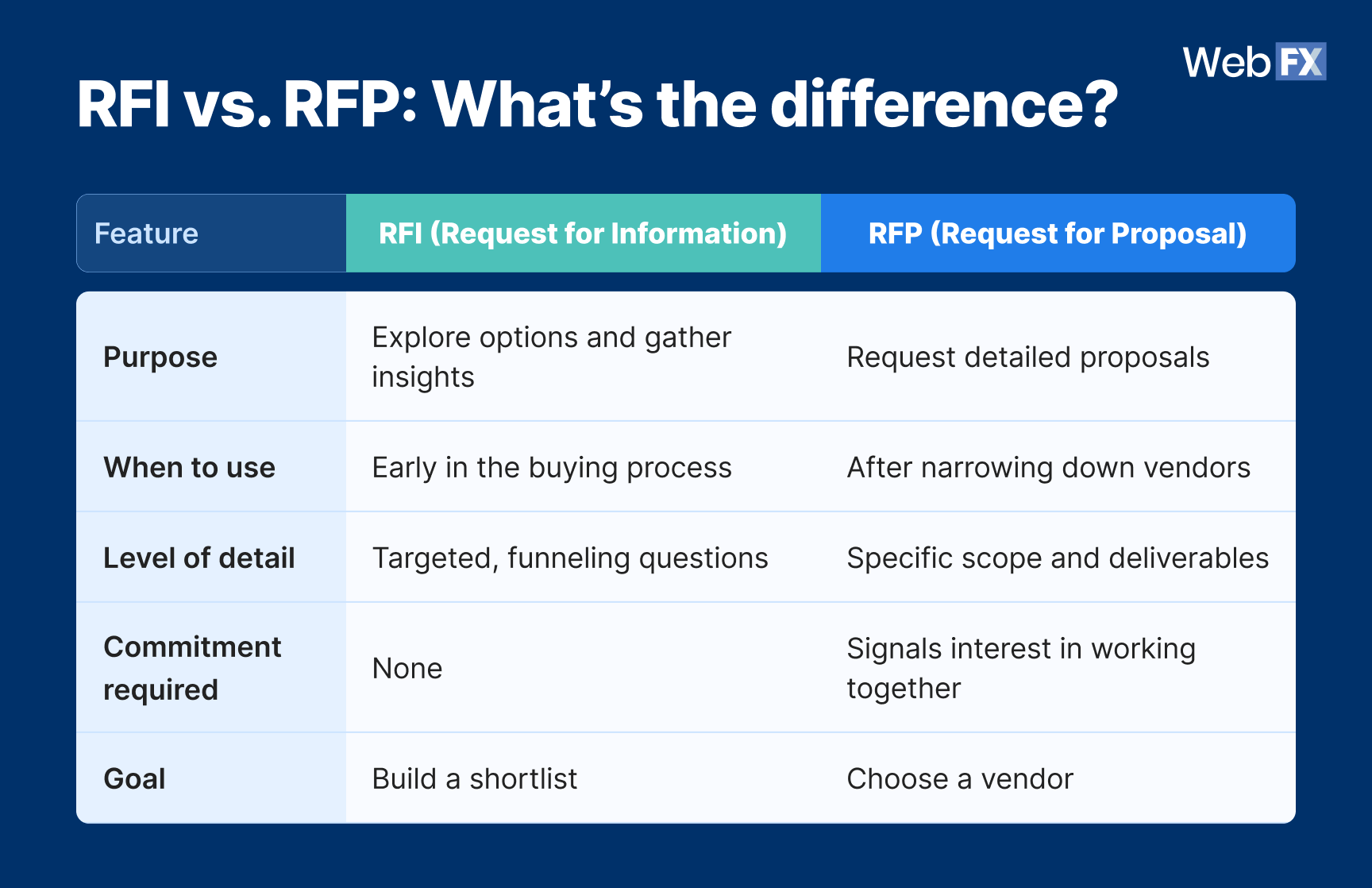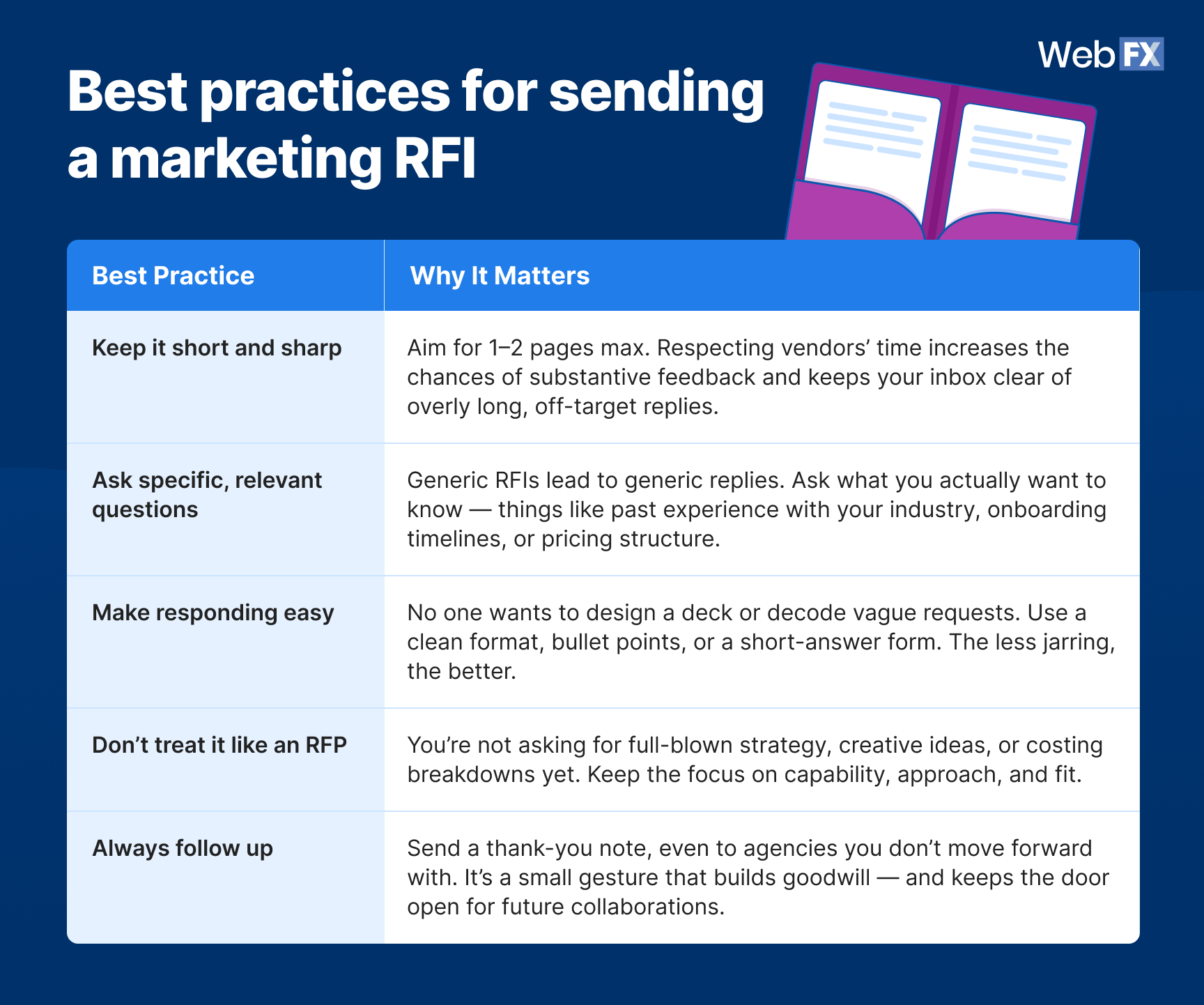Table of Contents
- What is an RFI for marketing?
- When should you use an RFI in marketing?
- RFI vs. RFP: What’s the difference?
- How to write an RFI for marketing
- Best practices for sending a marketing RFI
- Why RFIs matter in marketing procurement
- How to evaluate marketing RFI responses
- What happens after the RFI?
- FAQs about marketing RFIs
- Build better briefs, land better teams
-
What is an RFI for marketing?
A Request for Information (RFI) is a short, structured document sent to potential vendors to gather high-level insights about their services, strengths, and experience before committing to detailed proposals or RFPs. -
When should you send an RFI?
Send an RFI when exploring unfamiliar marketing services, vetting agencies before issuing a full RFP, comparing different vendor approaches to the same challenge, or clarifying core services, case studies, and pricing structures. -
How does an RFI differ from an RFP?
An RFI is an early discovery tool for gathering general information and vetting potential partners, while an RFP is a formal solicitation for detailed proposals, pricing, and strategic plans from pre-qualified vendors. -
What should a marketing RFI include?
A well-structured RFI should contain company background, project overview with objectives and timelines, key questions about services and experience, clear submission instructions with deadlines, and optional evaluation criteria to help vendors understand priorities. -
How do you evaluate RFI responses effectively?
Look beyond buzzwords to assess genuine alignment, review clarity and customization in responses, prioritize fit over flashy presentations, map responses to your stated priorities, and shortlist vendors for follow-up calls or a more detailed RFP process.
TL;DR: What is an RFI?
A Request for Information (RFI) is a document businesses use to collect insights from potential vendors before requesting detailed proposals. In marketing, it helps you explore agency capabilities, compare services, and clarify your goals — all before committing to a contract or sending a Request for Proposal (RFP).
Is your inbox flooded with “award-winning” marketing agencies that all sound the same? You’re not alone. Picking the right partner shouldn’t feel like guessing in the dark — or worse, sitting through a dozen bloated proposals that completely miss the mark.
That’s where a Request for Information (RFI) steps in. This underrated procurement move helps you cut through the noise, gather real insights, and size up vendors before you waste time on sales calls or detailed Request for Proposals (RFPs).
Let’s break down exactly what it is, why it matters, and how to do it right:
- What is an RFI for marketing?
- When should you use an RFI in marketing?
- RFI vs. RFP: What’s the difference?
- How to write an RFI for marketing
- Best practices for sending a marketing RFI
- Why RFIs matter in marketing procurement
- How to evaluate marketing RFI responses
- What happens after the RFI?
- FAQs about marketing RFIs
What is an RFI for marketing?
An RFI for marketing is your scouting report. It’s a short, structured document you send to potential vendors to get the lay of the land — without committing to anything yet.
It’s the warm-up round before the main event: Not a full-blown pitch request, but definitely more than just dipping a toe in. You’re asking agencies to show you what they’re about — their services, strengths, and experience — so you can gauge their fit before diving into deeper conversations.
You’re not looking for detailed strategies or polished pricing proposals just yet. You’re gathering high-level insights to:
- Understand what’s possible in the current market
- Spot real contenders from the copy-paste crowd
- Build a sharper, more focused RFP when the time comes
RFIs are especially helpful when you’re exploring a new marketing channel, testing unfamiliar waters, or just need a sanity check before going all in.
When should you use an RFI in marketing?
83% of B2B buyers now favor a self-directed approach to gathering information during the discovery phase of their buying journey.
If you’re unsure when an RFI makes sense in your process, here’s your cheat sheet. Below are four common (and critical) situations where sending an RFI in marketing can save time, reduce friction, and lead to better decisions.
1. You’re exploring marketing services but don’t know what’s out there
Maybe you’ve heard of programmatic ads, influencer campaigns, or answer engine optimization (AEO) — but you’re not sure what’s right for your business. An RFI helps you collect insights and see what kinds of strategies and services are available in today’s market.
2. You want to vet agencies before sending a full-blown RFP
RFPs take time — both to create and evaluate. An RFI acts as your early filter. It lets you identify viable prospects and weed out agencies that aren’t aligned with your goals, industry, or budget.
3. You’re not sure how different vendors approach the same challenge
Let’s say you’re launching a new product. One agency might recommend an end-to-end PPC strategy. Another might lean into organic marketing and social media promotion. RFIs give you a window into how different players think and operate — before they pitch you.
4. You need a clearer picture of core services, case studies, or pricing structures
Instead of relying on vague website claims or generic pitch decks, use an RFI to ask for relevant case studies, onboarding timelines, or even high-level pricing models. It helps you make smarter comparisons.
In short, an RFI in marketing is your due diligence — the move that makes sure you’re not flying blind when the real decisions roll in.
RFI vs. RFP: What’s the difference?
At first glance, a Request for Information (RFI) and a Request for Proposal (RFP) might sound interchangeable — but they play two very different roles in the marketing procurement process.
If you skip straight to an RFP, you might find yourself overwhelmed with detailed proposals that don’t align with what you actually need. On the flip side, starting with an RFI gives you space to explore, ask savvy questions, and avoid unnecessary back-and-forth between you and your vendors.
Here’s how an RFI for marketing stacks up against an RFP:

An RFI in marketing gives you breathing room — a chance to assess the grand scheme and gain clarity before locking yourself into detailed timelines, budgets, or scopes. It serves as the pre-game strategy session that sets you up for a winning play when you’re ready to send out that RFP.
How to write an RFI for marketing
77% of B2B buyers describe their latest purchase experience as extremely complicated or strenuous — systematic steps like RFIs can simplify it.
Not sure how to write an RFI for marketing that actually gets useful responses? You’re in good company. Many businesses send unclear, overstuffed requests that confuse more than clarify. But an expertly written RFI should do the opposite — it should spark precision, interest, and momentum.
RFIs work best when you follow an intentional structure — one that invites valuable input instead of canned replies. Whether you’re new to RFIs or just need a framework that works, here’s exactly how to weave a Request for Information for marketing that earns respect and real answers:
1. Company background
Set the stage with context that matters. Briefly introduce your brand — who you are, what you do, who you serve, and why this marketing initiative matters now. This isn’t just background fluff. It helps vendors tailor their responses to your mission, tone, and audience.
2. Project overview
Outline what you’re hoping to achieve. Be clear about your objectives (lead generation, rebranding, new product launch, etc.), the challenges you’re facing, and the marketing channels you’re considering. Include any relevant timelines, budget ranges (if known), and why this project is a priority.
3. Key questions
Don’t just collect facts — ignite meaningful insight. Ask questions that reveal an agency’s depth, flexibility, and thinking style. Think of this section as a conversation starter, not a checklist.
- What marketing services do you specialize in?
- Can you share examples of similar campaigns?
- What industries do you have experience in?
- How does your onboarding process work?
- What pricing models or retainers do you offer?
- How do you typically measure success for your clients?
4. Submission instructions
Make your ask frictionless. Provide a clear response deadline, formatting preferences (e.g., Google Doc, PDF, form), a word limit if necessary, and contact information for follow-up. Mention that this RFI is part of your early research and could lead to a formal RFP — it cues in transparency and encourages sizable replies.
5. Optional but impactful: Evaluation criteria
If you want to go next-level, append a short note about what you’re prioritizing (e.g., relevant experience, culture fit, tech stack familiarity). It helps vendors understand how their response will be assessed — and saves you time sifting through misaligned replies.
You can also add a quick preface that this is a discovery step before a potential RFP — so vendors know you’re serious, but not yet soliciting full proposals. By sticking to a clear structure like this, your RFI signals professionalism and purpose — and draws in vendors who are ready to bring their A-game.
Best practices for sending a marketing RFI
You’ve built a strong RFI — now here’s how to send it in a way that gets noticed, respected, and answered.
A thoughtfully mapped RFI for marketing doesn’t just make life easier for you and the vendors — it also sets the tone for better communication and stronger alliances.
Here’s how to do it right:

Sending a Request for Information for marketing might sound simple — but the results you get always depend on how you show up and what you ask.
Why RFIs matter in marketing procurement
When everyone’s selling their “secret sauce,” RFIs let you control the narrative. Instead of reacting to what vendors want to pitch, you guide the conversation around what you need.
Starting with an RFI isn’t just about gathering information — it’s your first move in shaping how you appraise partnerships, define what success looks like, and stay in control of your time and process.
Here’s why it pays off:
| Benefit | What It Looks Like |
| Avoid misaligned proposals | Filter out distractions and sideline vendors who aren’t a match — before they invest time preparing a response that falls flat. |
| Compare vendors on equal footing | By asking the same questions upfront, you make it easier to do apples-to-apples analyses. |
| Clarify your own needs before writing an RFP | Writing the RFI forces you to reflect on what matters most — so your RFP will be stronger and more targeted. |
| Start the agency relationship on the right foot | It signals mutual respect, sets communication expectations, and shows that you’re serious about making a smart, strategic choice. |
An RFI is a simple but powerful step in marketing procurement — one that helps you build better connections and drive better results.
How to evaluate marketing RFI responses
Once the RFI responses start rolling in, the real work begins: Separating surface-level pitches from genuine potential. A great RFI only gets you halfway — the rest depends on how you assess the replies.
Here’s how to examine responses with confidence and coherence:
1. Look beyond buzzwords
Agencies love their lingo. But don’t be easily dazzled by jargon like “data-driven” or “full-funnel.” Focus on whether their experience, processes, and examples actually align with your goals.
2. Assess clarity and customization
Did they tailor their response to your company, industry, or objectives? Or does it read like a recycled pitch? The level of effort here signals how seriously they’re taking the opportunity.
3. Review fit, not flash
A beautiful PDF isn’t worth much if the content doesn’t match your needs. Prioritize vendors who demonstrate a strong understanding of your challenges, audience, and desired outcomes — even in a brief response.
4. Map responses to your priorities
Go back to your evaluation criteria (if you included one). See how each vendor aligns with the factors that make or break: Relevant experience, team structure, pricing flexibility, tech stack knowledge, etc.
5. Shortlist and prepare next steps
Narrow it down to a few front-runners. From here, you can either hop on intro calls, request follow-up materials, or move forward with a more detailed RFP.
An RFI is only as powerful as what you do with the responses. Audit wisely, and you’ll not only save time but pave the way for more productive, strategic vendor relationships.
What happens after the RFI?
An RFI isn’t just a box to tick — it’s the launchpad for deeper engagement. Once you’ve reviewed the responses and identified the cream of the crop, the real momentum begins.
And that momentum matters. According to Infuse Insights, 83% of B2B buyers prefer to make the first move — not the vendor. A solid RFI process equips you with useful, vendor-neutral information that clarifies priorities and streamlines decision-making.
Most teams use their RFI insights to shape a more detailed RFP or kick off discovery calls with shortlisted vendors. At this stage, you’re evaluating more than just competencies — you’re gauging chemistry, collaboration style, and alignment on goals.
Still on the fence about scope or direction? Consider a small test project or pilot campaign. It’s a practical, low-risk way to validate expertise and see how each agency can (or cannot) raise the bar.
FAQs about marketing RFIs
What is an RFI in marketing?
A Request for Information (RFI) in marketing is an early-stage document sent to potential vendors to gather information about their capabilities, services, and fit — before issuing a full Request for Proposal (RFP).
What’s the difference between an RFI and an RFP?
An RFI is used earlier in the buying process to gather general information about potential vendors. An RFP comes later and requests detailed strategies, timelines, and pricing.
How to write an RFI for marketing that gets results?
Focus on brevity, clarity, and relevance. Include business context, marketing goals, a few specific questions, and your submission guidelines. Make it easy for vendors to respond with meaningful input.
How long should an RFI be?
Keep it concise — ideally 1–2 pages. A succinct Request for Information for marketing is more likely to get quality responses and gather insights without overwhelming your potential partners.
Should I include a budget in my RFI?
It’s optional, but including a budget range can help vendors assess fit and tailor their responses more effectively.
How many vendors should receive my RFI?
It depends on your goals, but a good rule of thumb is 4–6 vendors. Enough to get variety — but not so many that reviewing becomes overwhelming.
Should I follow up after sending an RFI?
Yes. A quick thank-you and note about next steps creates goodwill and keeps communication open.
Build better briefs, land better teams
A well-crafted RFI does more than collect surface-level details — it lays the groundwork for high-impact marketing partnerships grounded in mutual clarity, trust, and results. The way you approach this first step speaks volumes about how you work, what you value, and who you want at the table.
Want to skip the stress of sourcing and vetting vendors from scratch? WebFX is a full-service digital marketing agency with over 29 years of experience driving 24,859,684+ leads for clients and generating $10 billion in revenue for businesses like yours. So, if you’re looking to boost revenue, attract qualified leads, and grow your brand online, we’re ready when you are.
Contact us online or call 888-601-5359 to speak with a strategist about how our digital marketing services can fuel your pipeline and future-proof your success.
-
 Albert Dandy Velasquez blends SEO strategy with compelling storytelling to help businesses boost their visibility and revenue online. With a B.A. in English and certifications from HubSpot, Semrush, and Google Analytics, he has written and optimized hundreds of articles on organic SEO, content strategy, and user experience. He regularly contributes to the WebFX blog and SEO.com, creating content that helps readers turn marketing goals into measurable results. When he’s off the clock, he’s usually exploring new neighborhoods on two wheels, filming travel content, or chasing golden hour with a coffee in hand.
Albert Dandy Velasquez blends SEO strategy with compelling storytelling to help businesses boost their visibility and revenue online. With a B.A. in English and certifications from HubSpot, Semrush, and Google Analytics, he has written and optimized hundreds of articles on organic SEO, content strategy, and user experience. He regularly contributes to the WebFX blog and SEO.com, creating content that helps readers turn marketing goals into measurable results. When he’s off the clock, he’s usually exploring new neighborhoods on two wheels, filming travel content, or chasing golden hour with a coffee in hand. -

WebFX is a full-service marketing agency with 1,100+ client reviews and a 4.9-star rating on Clutch! Find out how our expert team and revenue-accelerating tech can drive results for you! Learn more
Try our free Marketing Calculator
Craft a tailored online marketing strategy! Utilize our free Internet marketing calculator for a custom plan based on your location, reach, timeframe, and budget.
Plan Your Marketing Budget
Table of Contents
- What is an RFI for marketing?
- When should you use an RFI in marketing?
- RFI vs. RFP: What’s the difference?
- How to write an RFI for marketing
- Best practices for sending a marketing RFI
- Why RFIs matter in marketing procurement
- How to evaluate marketing RFI responses
- What happens after the RFI?
- FAQs about marketing RFIs
- Build better briefs, land better teams

Proven Marketing Strategies

Proven Marketing Strategies
Try our free Marketing Calculator
Craft a tailored online marketing strategy! Utilize our free Internet marketing calculator for a custom plan based on your location, reach, timeframe, and budget.
Plan Your Marketing Budget
 Content Specialist
Content Specialist
What to read next





